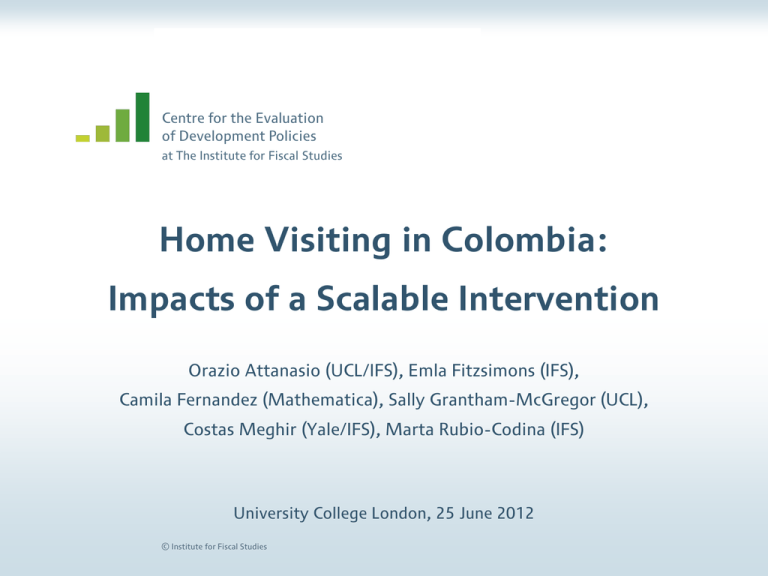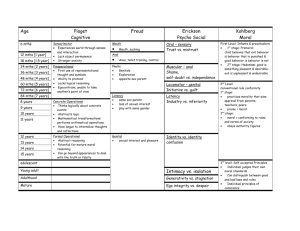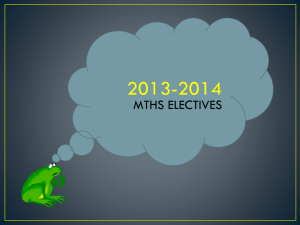Home Visiting in Colombia: Impacts of a Scalable Intervention of Development Policies
advertisement

Centre for the Evaluation
Centre for the Evaluation
of
Development
Policies
of Development
Policies
at
Institute
for Fiscalfor
Studies
atThe
The
Institute
Fiscal
Studies
Home Visiting in Colombia:
Impacts of a Scalable Intervention
Orazio Attanasio (UCL/IFS), Emla Fitzsimons (IFS),
Camila Fernandez (Mathematica), Sally Grantham-McGregor (UCL),
Costas Meghir (Yale/IFS), Marta Rubio-Codina (IFS)
University College London, 25 June 2012
© Institute for Fiscal Studies
Promoting Human Capital:
Early Years Interventions
• What happens in the early years has long lasting effects on
the physical, emotional and economic wellbeing of individuals
much evidence, including Walker et al (2005, 2006); Gertler et al (2012);
Schweinhart et al. (2005); Hoddinott et al (2008); Maluccio et al (2009); etc.
• Research evaluating the impact of policies on adult outcomes
suggests that early interventions yield higher returns
idea formalised by Cunha, Heckman and Schennach (2010)
• Role of dynamic complementarities
ECD Interventions: Outstanding Issues
1. How to design scalable interventions that are both:
cost effective?
sustainable?
2. How do (can) these interventions affect household behaviour
permanently, in terms of investments in children, crowding-in or
crowding-out of resources?
3. What role do different inputs play – interactions?
4. Externalities in knowledge transmission: spillovers of these
interventions in the family and the broader community?
This Project
• Design, implement and evaluate an intervention in Colombia, in
collaboration with a Government Agency, including:
1. Psycho-social stimulation via home visits
2. Micronutrient supplementation
• Two new elements:
1. Intervention: exploit the existence of Familias en Acción
and use local resources (local women) for implementation
cost-effectiveness & scalability
2. Research Design: collect detailed data to
identify mechanisms: model the behavioural impact of
the intervention
estimate a human capital production function
This Project
1. How to design scalable interventions that are both:
cost effective?
sustainable?
2. How do (can) these interventions affect household behaviour
permanently, in terms of investments in children, crowding-in or
crowding-out of resources?
3. What role do different inputs play – interactions?
4. Externalities in knowledge transmission: spillovers of these
interventions in the family and the broader community?
The Colombian Intervention:
Main Innovative Element
• Since 2002, Colombia has had in place a Conditional Cash Transfer
program, Familias en Acción, which is now the largest welfare
program in the country.
• Beneficiary women elect a representative: Madre Líder
• Madre Líderes are distinguishable for their leadership skills and
community networking abilities.
• We draw on these human resources available in the communities:
train and hire “Madre Líderes” to deliver the psycho-social
stimulation curriculum through home visits
Using Community Resources
• Key Element for Scalability & Sustainability:
1. Low(er) intervention costs
2. Community mobilization and information spread: local women
may become agents of change within their communities
3. Communities may take ownership of the intervention
4. Scheme easily replicable in other less developed contexts
• Challenges to Sustain Quality:
1. Identify suitable women
2. Adjust intervention to ability of home visitor and to delivery at
scale
3. Adequate training, continuous mentoring and supervision
The Colombian Intervention: Design
• Targeted to children aged 12-24 months in FeA beneficiary hhlds
in 96 semi-urban communities in 3 regions
1. Weekly Home Visits:
– lasting for 1 hour
– delivered by specially trained “Madre Líderes”
– based on the original Jamaican curriculum, adapted to the
Colombian context and the intervention reality
2. Micronutrient supplementation:
– Tasteless sprinkles, which are a mix of vitamins, iron and zinc
• The interventions lasted for 18 months, starting in Feb-May 2010
Intervention Design
6 mentors/supervisors
8 communities
per mentor
88CC
8C
8C
8C
HV
1
Region 1
HV
2
8C
HV
HV 3
3
5
5
5
kids
kids
kids
Region 2
8C
8C
3 home visitors
per community
5 children per
home visitor
15 per community
Region 3
Implementation Details
1. Hiring & Training of Supervisors
– 6 weeks training in Bogota (+ 2 briefing sessions)
2. Identification of Home Visitors
– Madre Líderes (60%)
– Reading comprehension test, interest and time availability
3. Training of Home Visitors
– 3 weeks (2 + 1) in the field
4. Monitoring & Supervision
– Supervisor visits community once every 6 weeks (7 - 10 weeks)
– Phone communication throughout, text messages, bulletins
The Curriculum
Promote cognitive and
language development
Mother focused: support the
mother to promote her child’s
development
Teach through play:
•
rich in play materials
•
incorporate concepts/skills
to be taught in daily
routines
Organised by weeks to match
the developmental level of the
child to the extent possible
Keep costs down: use homemade toys, rotating toys
TRAINING HOME VISITORS
Conversation Scenes & Books
Evaluation: Randomised Control Trial
• 96 communities (municipios) of 5,000 – 50,000
inhabitants each (semi-urban) in 3 regions
• Randomly Assigned to 4 groups:
Stimulation
Micronutrient
Suppl.
Stimulation
+
Micronutrient
Suppl.
Control
Evaluation: Identify Sample of Children
1. Randomly drew 3 Madre Lideres (ML) per community
2. Randomly select 5 families with children 12-24 months at the
start of the intervention and represented by selected ML
3. Offered the ML the possibility to participate, tested her ability
and checked her availability
4. If the ML refused to participate or was not deemed suitable: we
replaced the ML BUT kept the same families to avoid selection
bias between treatment and control.
Identical process across intervention arms
Evaluation Timeline
• Feb – May 2010: Baseline Data Collection
– Socio-economic questionnaire (n = 1,429)
– Child development outcomes
– Information on mothers/carers & home visitors
• Phase-in intervention as baseline data were collected
• Collect process data on visits (frequency & quality) and intake of
micronutrients (maternal reports) throughout the intervention
• Sept - Dec 2011: Intervention ends & Follow Up Data Collection
(n = 1,330)
• Focus Groups with beneficiary mothers (Aug 2011)
Child & Home Environment Information
Test
Direct
Observation
Cognitive Development
Bayley-III
yes
Language: Expressive & Receptive
Bayley-III
Motor Development: Fine & Gross
Bayley-III
Outcome
Expressive Language
Temperament
Attention, Inhibitory Control, Sociability
yes
Yes
MacArthur-Bates
Bates
Rothbart
(follow up only)
Health Status & Morbidity
Weight, Height, Hb
yes
Child Care &Time Use
Quality of Home Environment
Toys & play activities, books adults
Family Care
Indicator
yes
Mother and Home Visitor Questionnaire
Mother
(Main
Caregiver)
Home Visitor
Education
X
X
Labour Supply
X
X
Time Use
X
X
Health (incl. Reproductive)
X
Weight, Height, Hb
X
Depression (CES-D)
X
Vocabulary Range (~ Peabody)
X
X
Knowledge on Child Development
(~ KIDI, own questions)
X
X
Sample Loss, Attrition & Precision
• Sample Loss between household survey and Bayley test
– Baseline: 9 children (0.62%)
– Follow Up : 55 children (4.13%)
• Attrition between survey rounds (18 months):
– Household Survey: [1.89% - 4.85%; mean =3.52%]
– Bayley Test: [6.78% - 8.66%; mean =7.51%]
small imbalance (under investigation...)
• Precision: spatial correlation once we condition on baseline
characteristics is about 0.04 or less (depending on the outcome)
effective sample size ~220 per variant
105
100
95
90
Bayley Cognitive Scores
110
Comparison with Bogota Study Data on Wealth Gradient
6
8
10 12 14 16 18 20 22 24 26 28 30 32 34 36 38 40 42
Age (months)
Bogota Wealth Quartile 1
Bogota Wealth Quartile 4
Pilot ECD (Control Group)
Empirical Strategy
3
𝑦𝑖𝑗 = 𝛼 + 𝛽𝑡
𝑇𝑡𝑗 + 𝛾 𝑦𝑜 +
𝑡=1
+ 𝛿1 𝑎𝑔𝑒 𝑝𝑜𝑙𝑦𝑛𝑜𝑚𝑖𝑎𝑙𝑖 + 𝛿2 𝑠𝑒𝑥𝑖 + 𝜆𝑒 + 𝜀𝑖𝑗
•
•
i: child, j: community, Tt = {stim, stim+micronutr, micronutr}, follow up data
: estimate of impact, “equivalent” to comparison of means (RCT)
•
Control for age (flexibly), sex, initial level of outcome at baseline
•
(le): tester effects (also a proxy for region)
•
Cluster SE at the community level
Effects on Cognition (Bayley) by Age at Intervention Start
All
0.251**
(0.073)
Stim (in SD)
12-18 mths 18-24 mths
0.197+
0.357**
(0.111)
(0.092)
-.2
-.1
0
.1
.2
.3
n =1267; +significant at 10%, *significant at 5%, **significant at 1%
12
14
16
18
20
Age at Start (in months)
Stimulation Only
22
24
Control
Impacts on Cognitive scores, increasing with age
Effects on Receptive Language (Bayley) by Age at Start
Stim (in SD)
All
0.188**
(0.080)
12-18 mths 18-24 mths
0.174
0.258*
(0.113)
(0.120)
-.2
-.1
0
.1
.2
.3
n =1267; +significant at 10%, *significant at 5%, **significant at 1%
12
14
16
18
20
Age at Start (in months)
Stimulation Only
22
24
Control
Impacts on Expressive Language, increasing with age
Effects on Expressive Language (Bayley) by Age at Start
All
0.059
(0.073)
Stim (in SD)
12-18 mths 18-24 mths
0.023
0.191
(0.122)
(0.159)
-.2
-.1
0
.1
.2
.3
n =1267; +significant at 10%, *significant at 5%, **significant at 1%
12
14
16
18
20
Age at Start (in months)
Stimulation Only
22
24
Control
No significant effects on Expressive Language, assessed on the Bayley
Effects on Expressive Language :
MacArthur-Bates (maternal report)
NUMBER WORDS CHILD CAN SAY
Stimulation Only
Mean Dep Var (Controls)
All
12-18 mths
18-24 mths
4.238*
1.232
5.266*
(2.116)
(2.754)
(2.592)
55.46
48.04
61.20
n =1325; *significant at 5%
NUMBER OF COMPLEX SENTENCES
Stimulation Only
Mean Dep Var (Controls)
n =1325
All
12-18 mths
18-24 mths
0.365
0.0582
0.275
(0.381)
(0.526)
(0.533)
5.43
4.53
6.69
Some Heterogeneity in Impacts
COGNITION
Stim =1
Stim*Age Child (mths)
-5.829*
(2.764)
0.188*
(0.075)
Stim*Low Edu Mother =1
0.718*
(0.341)
1.039**
(0.329)
-3.835
(2.755)
0.122+
(0.075)
1.091+
(0.564)
Stim*Hh Wealth Index
Age Child (mths)
RECEPTIVE LANGUAGE
0.0699
(0.075)
0.178**
(0.053)
Hh Wealth Index
n =1267; +significant at 10%, *significant at 5%, **significant at 1%
0.630*
(0.296)
0.620
(0.502)
-0.414
(0.348)
0.171**
(0.054)
Age Child Sq (mths)
Low Edu Mother =1
0.424
(0.273)
-1.663**
(0.439)
0.856**
(0.248)
2.193**
(0.439)
-0.028**
(0.006)
2.268**
(0.445)
-0.028**
(0.006)
-1.133**
(0.362)
-0.0297
(0.305)
2.376**
(0.450)
-0.030**
(0.006)
0.463*
(0.222)
Effects by Treatment Group – All Children
COGNITION
(Bayley)
RECEPTIVE EXPRESSIVE NUMBER
LANGUAGE LANGUAGE
WORDS
(Bayley )
(Bayley) (MacArthur)
DIFFICULT
CHILD
(Bates)
Stimulation
0.251**
(0.073)
0.188**
(0.080)
0.0592
(0.073)
3.830+
(2.008)
-0.541+
(0.288)
Stim + Micronutr
0.205**
(0.070)
0.163*
(0.073)
0.0826
(0.083)
4.238*
(2.116)
-0.161
(0.251)
Micronutrients
0.0467
(0.059)
0.0393
(0.084)
0.0836
(0.087)
3.634+
(1.911)
-0.0597
(0.262)
1,267
1,267
1,267
1,325
1,325
N
+significant at 10%, *significant at 5%, **significant at 1%
-
Impacts of combined interventions (“stim+micronutrients”) not
significantly different from “stimulation” intervention alone.
No impact of micronutrient supplementation on cognition, language,
difficult child
First Hint at Mechanisms:
Increased Parental Investment in Children
Varieties of
Play
Play Activities
Books
Materials (previous 3 days) for Adults
Home
Made Toys
Bought
Toys
Stimulation
0.914**
(0.180)
0.284*
(0.134)
0.556**
(0.128)
0.564**
(0.152)
0.0188
(0.081)
Stim + Micronutr
0.719**
(0.189)
0.167
(0.133)
0.452**
(0.137)
0.731**
(0.153)
0.140
(0.087)
0.0886
0.337*
(0.187)
(0.151)
n =1329; *significant at 5%; **significant at 1%
0.213
(0.167)
0.217
(0.153)
0.104
(0.087)
Micronutrients
• Suggestive
evidence of “crowding-in” of resources
Intervention Costs & Scalability
• Cost of the intervention is $491 USD per child per year
Budget Item
Supervisors
Materials Stimulation
Wages Home Visitors & Training
Micronutrients
Wages MLs Micronutrients & Training
USD
child/year
265.2
13.1
186.1
15.4
11.3
491.11
%
54%
2.6%
37.8%
3.1%
2.3%
• At scale, supervision costs could be reduced substantially if
supervisors were selected from neighbouring towns.
• Colombian government ECD Strategy (0 a 5iempre) ~ $1,300 USD
per child per year budgeted
Conclusions
• Well designed cost-efficient large scale interventions can have
significant impacts on child development in the short run:
1. Impacts of 25% and 19% of a SD increase in cognition and
receptive language
2. Impacts tend to increase with age of the child: larger impacts
for children 18 to 24 mths at the start: 36% of a SD in
cognition and 26% of a SD in language
[age at start of intervention or age at the time of testing?]
3. Smaller impacts on expressive language and child
temperament (mother reports)
4. Increased parental investments in children
What Next?
• Understand better the decisions parents make and the child
production function (substitutability of different inputs)
• Understand better the role of micronutrients
• We are also going to collect more evidence:
1. Further follow-ups of the study sample
2. New experiment to address externalities in knowledge
transmission in Orissa, India
3. Study the complementarities between home- and centerbased interventions design integrated 1 to 5 intervention
Thank you
Other stuff
Characteristics Well Balanced at Baseline
Child
Age (months)
Male =1
Premature =1
Birthweight
Controls
Stimulation Stim + Micronutr Micronutrients
18.266
0.491
0.198
3230.8
18.003
0.461
0.135
3252.2
17.790
0.524
0.161
3240.9
18.067
0.497
0.120
3238.4
Mother
Age Mother
Education Years Mother
Mother Work =1
26.09
7.715
0.472
26.56
7.194
0.439
26.01
7.426
0.448
26.42
7.490
0.462
Household
Dirt Floors =1
Crowding Index
Computer =1
Fridge =1
Wealth Index
0.034
0.598
0.043
0.537
-0.076
0.075*
0.577
0.047
0.578
0.026
0.078+
0.589
0.050
0.619
0.049
0.034
0.598
0.043
0.586
0.002
Home Environment
Books for Adults
Bought Toys =1
Nb Play Activities
Home Environment Score
1.117
0.786
3.706
7.060
1.061
0.739
3.706
7.094
1.022
0.782
3.709
6.863
1.031
0.763
3.579
6.624
Baseline Balance: Dependent Variables
Cognition (Bayley)
Receptive Language (Bayley)
Expressive Language (Bayley)
Fine Motor (Bayley)
Gross Motor (Bayley)
Nb Words Says (McArthur)
Nb Words Unders (McArthur)
Unstoppable (Bates)
Unadaptable (Bates)
Unsociable (Bates)
Difficult (Bates)
Controls
52.152
20.487
20.436
34.805
50.441
22.948
40.620
10.551
4.780
7.980
18.451
Stimulation Stim + Micronutr Micronutrients
51.542
51.493
51.824
20.348
19.885
20.011
20.379
19.675
19.944
34.534
34.127
34.078
50.919
50.424
50.291
22.894
21.441
22.073
39.448
40.233
41.754
10.275
10.843
10.630
4.872
5.048
5.117
8.058
7.969
8.050
18.294
19.056
18.708
No significant differences in the levels of the main outcomes between
groups at baseline
Profiling Home Visitors – can i fit this somewhere?
• All are literate (requirement)
• 60% are “Madre Lideres”
• 56% work
• 70% are married/cohabiting
• Kids <6...53% have no children; 35% have 1 child; 12%
have 2-4 children
• Compared to mums:
– 15% of mums are the same age or older than home visitor
– 47% of mums have the same or more years of education
than home visitor
– 37% of mums score higher on the Peabody Test than home
visitor





